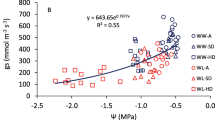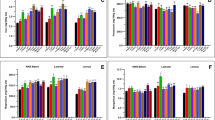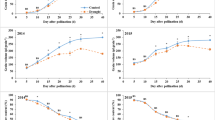Abstract
RESERVES of assimilate present in wheat and barley crops at flowering, and available for later translocation to the grains, could buffer grain yield against environmental stresses during grain filling. This so-called pre-anthesis assimilate contribution to grain yield can be expressed as a percentage of yield (P1). Archbold1, and later Thorne2, concluded that P1 was small, being no more than 20%2. But only one result (12% for irrigated wheat at Cambridge3) refers to a crop in the field as distinct from plants in pots, and no studies considered the effect of stress during grain filling. Recently Gallagher et al.4,5 reported substantial contributions: P1 averaged 43% over six crops of wheat and barley at Nottingham; this amounted to more than 300 g per m2 of dry material in two crops and, in the severe drought of 1970, 39% of total dry matter present at anthesis. They assumed, with some supporting evidence from one barley crop6, that the pre-anthesis contribution was given by the decrease from anthesis to maturity in dry weight of non-grain parts of the crop. In situ labelling with 14CO2 of the whole crop canopy at frequent intervals before and after anthesis would seem to be the least equivocal way of estimating P1. Using this method we have determined P1 in wheat and barley. It averaged only 12% (watered crops) and 22% (droughted crops), and did not agree with estimates for the same crops obtained by the method of Gallagher et al.4,5.
This is a preview of subscription content, access via your institution
Access options
Subscribe to this journal
Receive 51 print issues and online access
$199.00 per year
only $3.90 per issue
Buy this article
- Purchase on Springer Link
- Instant access to full article PDF
Prices may be subject to local taxes which are calculated during checkout
Similar content being viewed by others
References
Archbold, H. K. Nature 156, 70–73 (1945).
Thorne, G. N. Rep. Rothamsted exp. Stn. 1973 2, 5–25 (1974).
Lupton, F. G. H. Ann. appl. Biol. 64, 363–74 (1969).
Gallagher, J. N., Biscoe, P. V. & Scott, R. K. J. appl. Ecol. 12, 319–36 (1975).
Gallagher, J. N., Biscoe, P. V. & Hunter, B. Nature 264, 541–2 (1976).
Biscoe, P. V., Gallagher, J. N., Littlejon, E. J., Monteith, J. L. & Scott, R. K. J. appl. Ecol. 12, 295–318 (1975).
Fischer, R. A. & Laing, D. R. J. agric. Sci., Camb. 87, 113–22 (1976).
Birecka, H. & Dakic-Wlodkowska, L. Acta Soc. Bot. Poloniae 35, 637–62 (1966).
Rawson, H. M. & Evans, L. T. Aust. J. Agric. Res. 22, 851–63 (1971).
Aguilar, I. & Fischer, R. A. Agrociencia (Mexico) 21, 185–98 (1975).
Midmore, D. J. thesis, Univ. Reading (1976).
Author information
Authors and Affiliations
Rights and permissions
About this article
Cite this article
BIDINGER, F., MUSGRAVE, R. & FISCHER, R. Contribution of stored pre-anthesis assimilate to grain yield in wheat and barley. Nature 270, 431–433 (1977). https://doi.org/10.1038/270431a0
Received:
Accepted:
Issue Date:
DOI: https://doi.org/10.1038/270431a0
This article is cited by
-
Dry matter remobilization from different plant parts of six durum wheat genotypes under water-restricted conditions and its compensatory effects on grain yield
Cereal Research Communications (2024)
-
Arbuscular mycorrhiza enhances maize grain yield and nitrogen uptake during the grain filling stage with contrasting nitrogen status in two types of soils
Plant Growth Regulation (2023)
-
A non-destructive approach for measuring rice panicle-level photosynthetic responses using 3D-image reconstruction
Plant Methods (2022)
-
N-fertilizer postponing application improves dry matter translocation and increases system productivity of wheat/maize intercropping
Scientific Reports (2021)
-
Genome-wide association analysis of stem water-soluble carbohydrate content in bread wheat
Theoretical and Applied Genetics (2020)
Comments
By submitting a comment you agree to abide by our Terms and Community Guidelines. If you find something abusive or that does not comply with our terms or guidelines please flag it as inappropriate.



